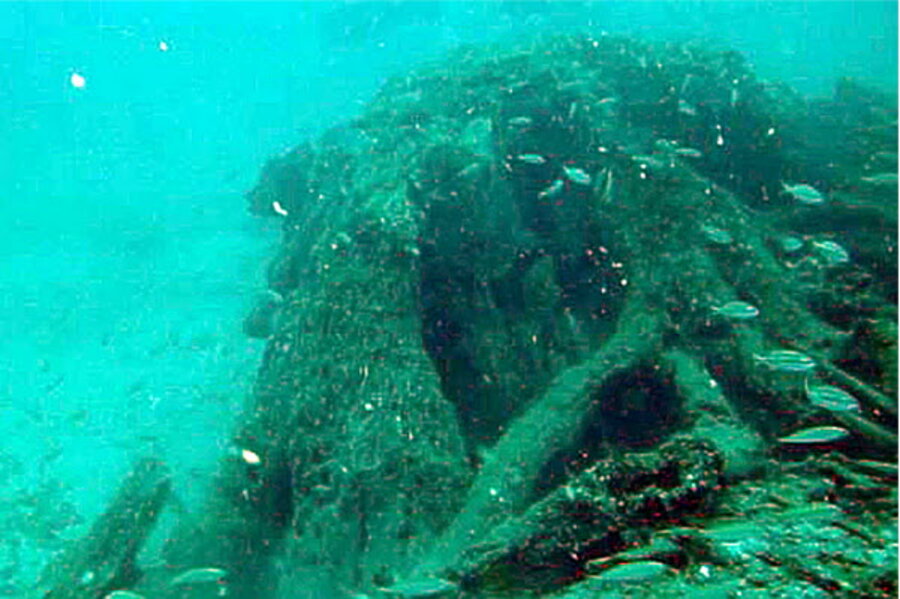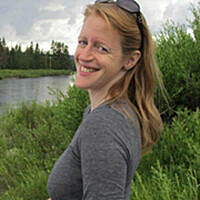'Enchanted forest' provides tantalizing hints to past climate.
Loading...
Sixty feet underwater, ten miles from shore, divers discovered cypress trees that had been buried for tens of thousands of years.
While most of the once-majestic trees are gone, sonar data has found between 50 and 100 stumps, as well as an unknown number of logs. The trees are closely related to the modern-day Bald Cypress, says Grant Harley, a tree ring expert at the University of Southern Mississippi. "The growth rings look just like the Bald Cypress growth rings I've looked at hundreds of times," he says.
And there were a lot of growth rings, so close together that Dr. Harley had to use a high-powered microscope to count them. In a sample the size of a coffee cup, he says, he found 424 years of growth rings. Considering that the larger tree stumps were upwards of six feet in diameter, these trees could easily be thousands of years old. "That's much, much older than Bald Cypress growing today," Harley notes. "It's more comparable to redwoods."
The forest itself has been dead at least 50,000 years, say scientists at the Lawrence Livermore Laboratory in California who dated samples from the trees by looking for carbon-14, a radioactive isotope that is found in every living organism but that steadily decays after the organism dies. The scientists had expected to find that the trees were about 12,000 years old – the age of the last big ice age, when sea levels were low – so they were surprised to find that the trees had no carbon-14 at all, which puts them older than 50,000 years.
Another surprise: the wood still seemed fresh. Ben Raines, one of the first scuba divers to explore the site, tweeted a picture showing the sap-rich wood.
“It is a little darker in color than a piece of modern cypress, but if I didn’t tell you that it was over 50,000 years old, you wouldn’t know it,” paleoclimatologist Kristina DeLong, the Louisiana State University research scientist who prepared the samples for carbon dating, told AL.com. “When I cut into them, they smelled just like you were cutting into a cypress tree.”
As he explored the site, Mr. Raines noticed that the outer edges of the trees are becoming softened and pockmarked – what Harley describes as "punky and friable" – but the inner wood is still hard enough to blunt a knife.
To be so well preserved, the forest must have been completely buried by seafloor sediments, say geologists. A thick enough layer of mud or clay could create an airtight seal that prevented decomposition, until hurricane Katrina's churning waves washed the trees bare.
“It certainly makes sense that these were preserved under anaerobic conditions,” Berry H. "Nick" Tew, the state geologist of Alabama, told Raines.
Harley agrees. "Now that they're in an aerobic environment," he warns, "I don't think we have too much longer." He estimates the forest has only a few years before the trees completely decompose. "Oxygen's attacking it, marine boring organisms are attacking it."
How the underwater forest was discovered
As the story goes, a fisherman went out to sea shortly after hurricane Katrina scoured the Gulf Coast. He found an unusual run of red snapper, and after fishing it for several days, he asked a scuba-diving friend to check out what could be causing the usually flat and boring sea floor to teem with life. "It's a forest," the diver reported. Dozens of cypress trees and stumps, reaching as far as he could explore.
The underwater forest remained a closely guarded secret for years, until Raines, a journalist and diver, tracked down the rumors and headed out with a camera. He shot photos and video footage of what he called an "enchanted forest," but he's keeping the location quiet, for fear of salvage loggers who would turn this unique discovery into furniture.
Raines's pictures reveal that new life has sprung up from these long-dead trees. More than 50,000 years ago, they rose 80 to 150 feet tall from rivers and estuaries, supporting an ecosystem filled with alligators, snakes, wading birds, and mosses. Now, these submerged stumps and fallen logs, dead since Neanderthal days, have created an artificial reef, supporting a coral-reef-like ecosystem of anemones, spidery arrow crabs, rockfish, red snapper, and more.
While he was down there, Raines picked up a piece of wood off the seafloor and cut loose another one. So far, those are the only specimens that have been gathered from the site. Raines tried to return last fall with Harley and Dr. DeLong, but their boat broke down en route.
What next?
Both DeLong and Harley are eager to get back to the forest and gather more samples, in hopes of piecing together a picture of the ancient forest. They're just waiting for the jet stream to warm and calm the waters of the Gulf, which should happen by late summer. They don't want to wait any longer than that – another hurricane could sweep into the area and rebury the site at any time.
"Today, Bald Cypress are sensitive to drought and precipitation," Harley says. If these ancient cousins of the Bald Cypress are as sensitive, their tree rings could reveal the climate in the Gulf Coast tens of thousands of years ago.
"We can match the pattern – the wide and narrow growth rings – and create a chronology that spans, I'm sure, several thousand years," says Harley.
The heart of dendrochronology, or tree ring history, is connecting the story told by the tree rings into an overlapping pattern, daisy-chaining the records from various trees together to create a climate record that is longer than any one tree could ever live. If each of these underwater trees is hundreds or, more likely, thousands of years old, then Harley and his team have "the potential to create a multi-millenial tree ring chronology," he says. This could tell the story of the ancient climate over the course of tens of thousands of years – but which years? That's the other key to dendrochronoloy: an anchor date. If you can get a firm date for just one tree ring, then you can extrapolate forward and backward through the entire chain.
Once they got the news that the two samples Raines had recovered were "radiocarbon dead," the scientists concluded that the trees probably lived during the previous glacial maximum, about 50,000 to 80,000 years ago, though they could theoretically be even older. They're now processing the samples for slower-decaying isotopes, such as uranium-thorium or potassium-argon, in hopes of finding that elusive anchor date. Harley also points out that that when they've collected more samples, odds are good that at least one of the trees will be younger than 50,000 years. "I'd be very surprised if every tree sample came back the same age," he says.
"As long as we're anchored in time by one radiocarbon date, then we could say something pretty cool about the environment, the climate back then," says Harley. "That would be the ultimate goal."








